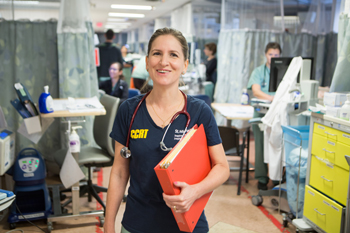Q&A with Eliane Stockler-Leite

By Geoff Koehler

Eliane Stockler-Leite, registered nurse and member of Critical Care Response Team. (Photo by Yuri Markarov)
Q. What is the Critical Care Response Team?
The CCRT is a group of critical care specialists — nurses, respiratory therapists and doctors — who are available 24-7 to provide critical care support outside of the intensive care units. We’re a safety net for patients whose condition might be getting worse. We’re also ready to respond when someone on the unit has a gut feeling and would simply like a second set of eyes or some education.
Q. How does the CCRT work with an inpatient unit?
Typically, an inpatient unit’s care team will call Locating for support. The CCRT will rush to the bedside, working with the primary nurse and the most-responsible physician to identify the patient’s issue. The CCRT also takes parts in rounds on units and does followup with patients who were recently discharged from one of the ICUs. On these occasions, the CCRT might identify a patient on the unit who needs their support. In either case, the unit’s staff knows the patient best and is working with us during our consult. Together, we assess the patient and quickly decide how to best treat the patient—whether on the unit or in the ICU.
Q. Are there ever any false alarms?
No. There’s no such thing as a false alarm with CCRT. Any time we, as a hospital, provide the best care possible, it’s a good day. If anyone is concerned, there’s reason for the CCRT to be involved. It’s better for someone to call when they have a gut feeling, than to wait until a situation becomes an emergency.
Q. What do you love about being on this team?
I have had numerous opportunities to not only share my expertise in critical care but also to learn from my expert colleagues from different specialties, from how to position an orthopedic patient after surgery, to how calm down an extremely anxious patient under psychiatric care, to what to look for after a patient has received chemo. I am constantly learning and building relationships.
I’ve worked on a busy acute care unit before. I know that staff give 100 per cent. The CCRT can help share that load. Responding to a call is an opportunity to care for patients, grow relationships and share the burden. I’d say that’s a win for the ward, for the CCRT and especially for the patient.
Q. After a day responding to calls, how do you kick back?
I’m a runner. Now I don’t run the same day as my shift, but definitely after I’ve gotten some sleep. Running helps put stressful days into perspective. I’ve done seven half-marathons. At work or on the trail, I always try my hardest and go the distance.
About St. Michael’s Hospital
St. Michael’s Hospital provides compassionate care to all who enter its doors. The hospital also provides outstanding medical education to future health care professionals in more than 29 academic disciplines. Critical care and trauma, heart disease, neurosurgery, diabetes, cancer care, care of the homeless and global health are among the Hospital’s recognized areas of expertise. Through the Keenan Research Centre and the Li Ka Shing International Healthcare Education Centre, which make up the Li Ka Shing Knowledge Institute, research and education at St. Michael’s Hospital are recognized and make an impact around the world. Founded in 1892, the hospital is fully affiliated with the University of Toronto.
